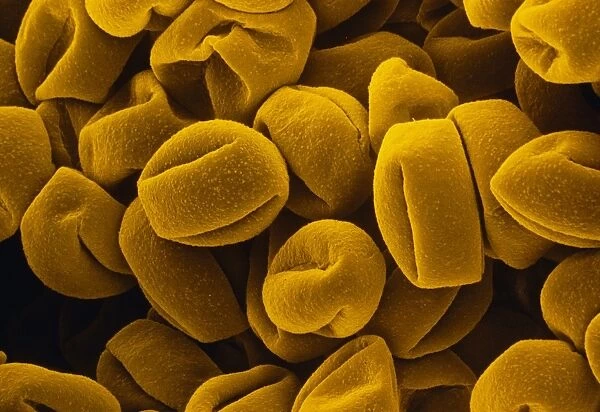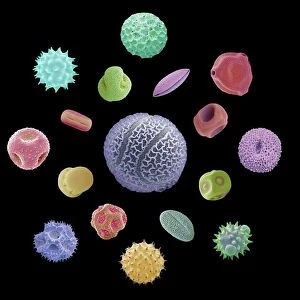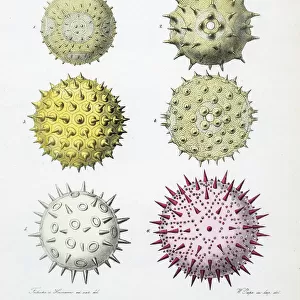Home > Science > SEM
Pollen grains from common Oak flower
![]()

Wall Art and Photo Gifts from Science Photo Library
Pollen grains from common Oak flower
False colour scanning electron micrograph (SEM) of pollen grains from the common oak flower Quercus robur. Oak trees flower in May/June producing copious quantities of pollen, which is dispersed by the wind. Oak pollen is a major cause of hay fever (medical term Allergic rhinitis & pollenosis). Sufferers produce an antibody, immunoglobin E (IgE), which attaches to cells in the nose & eyes. It reacts with inhaled pollen causing the release of various chemicals including histamine. Histamine causes the mucous membranes of the nose, eyes & throat to swell & become inflamed, bringing on the hay fever attack. Magnification: X 170 at 35mm size. original is bw print B786/90
Science Photo Library features Science and Medical images including photos and illustrations
Media ID 6288605
© DR JEREMY BURGESS/SCIENCE PHOTO LIBRARY
Allergy Common Oak Hay Fever Pollen Quercus Robur Re Production Reproductive Type
EDITORS COMMENTS
This print showcases the intricate beauty of pollen grains from a common Oak flower, Quercus robur. In this false color scanning electron micrograph (SEM), we are able to witness the delicate details and vibrant hues of these tiny particles. Oak trees bloom in late spring, specifically during May and June, producing an abundance of pollen that is dispersed by the wind. However, what may seem like a picturesque scene can be troublesome for many individuals who suffer from hay fever or allergic rhinitis & pollenosis. Hay fever occurs when individuals produce an antibody called immunoglobin E (IgE) in response to inhaling oak pollen. This IgE attaches itself to cells in the nose and eyes, triggering a series of reactions within the body. One such reaction involves the release of histamine and other chemicals that cause swelling and inflammation in the mucous membranes of the nose, eyes, and throat. The result? A full-blown hay fever attack characterized by sneezing fits, itchy eyes, runny noses, and general discomfort. With a magnification level of X 170 at 35mm size captured on black-and-white print B786/90 by Science Photo Library, this image not only highlights nature's remarkable reproductive process but also sheds light on one of its unintended consequences - allergies caused by oak pollen.
MADE IN THE UK
Safe Shipping with 30 Day Money Back Guarantee
FREE PERSONALISATION*
We are proud to offer a range of customisation features including Personalised Captions, Color Filters and Picture Zoom Tools
SECURE PAYMENTS
We happily accept a wide range of payment options so you can pay for the things you need in the way that is most convenient for you
* Options may vary by product and licensing agreement. Zoomed Pictures can be adjusted in the Basket.







